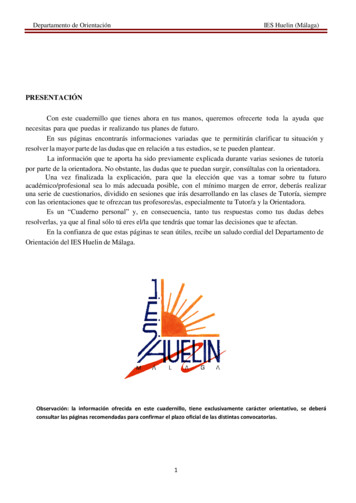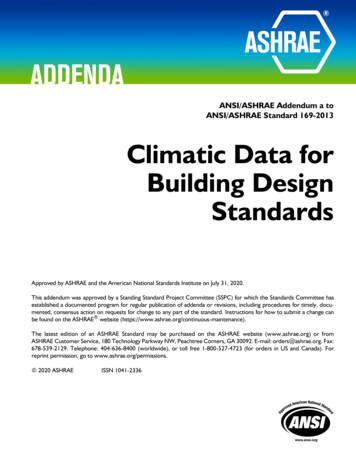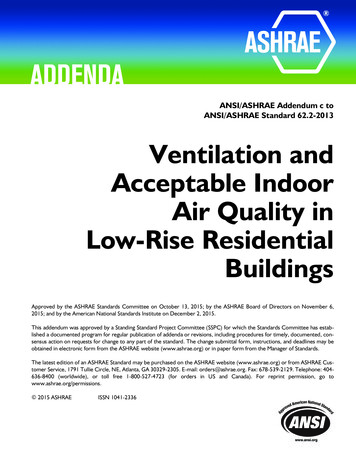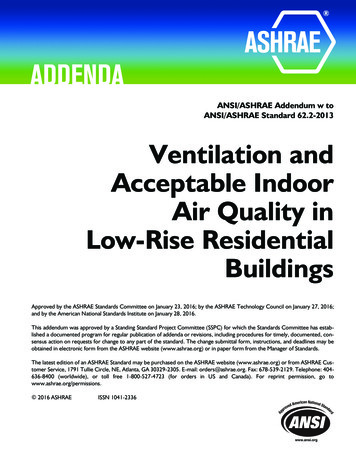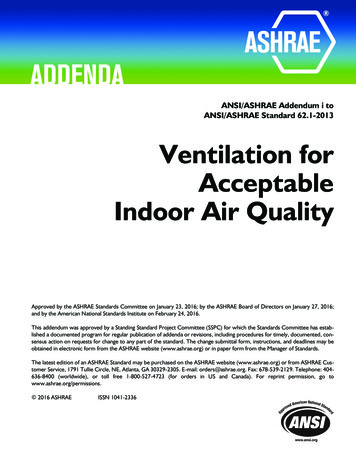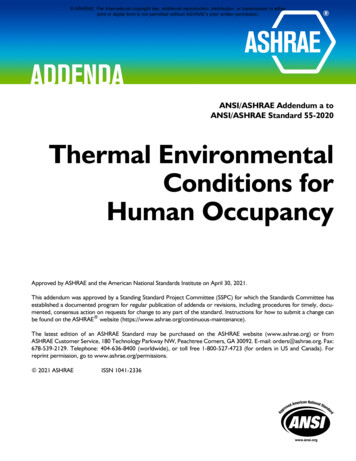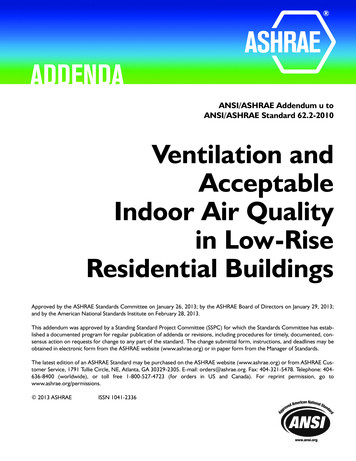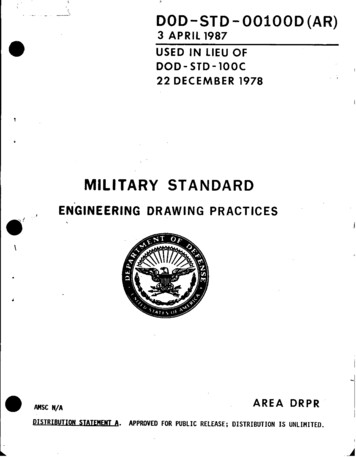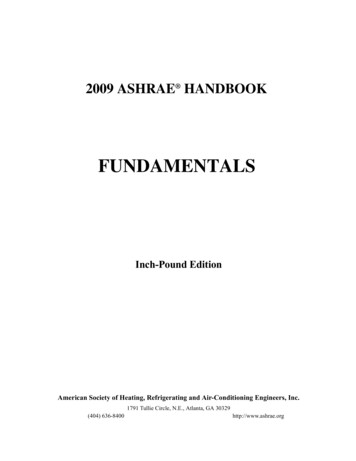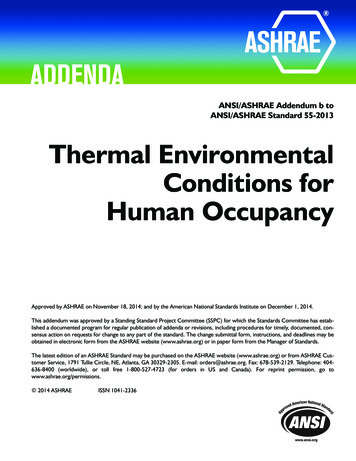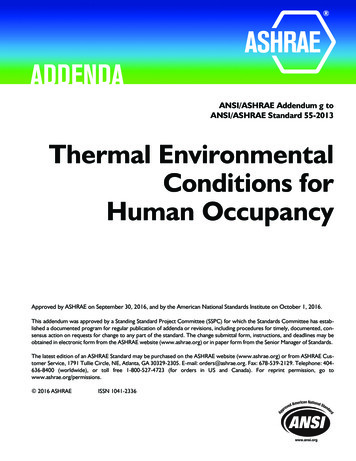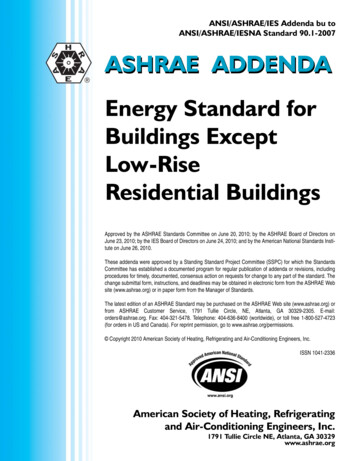
Transcription
ANSI/ASHRAE/IES Addenda bu toANSI/ASHRAE/IESNA Standard 90.1-2007ASHRAE ADDENDAEnergy Standard forBuildings ExceptLow-RiseResidential BuildingsApproved by the ASHRAE Standards Committee on June 20, 2010; by the ASHRAE Board of Directors onJune 23, 2010; by the IES Board of Directors on June 24, 2010; and by the American National Standards Institute on June 26, 2010.These addenda were approved by a Standing Standard Project Committee (SSPC) for which the StandardsCommittee has established a documented program for regular publication of addenda or revisions, includingprocedures for timely, documented, consensus action on requests for change to any part of the standard. Thechange submittal form, instructions, and deadlines may be obtained in electronic form from the ASHRAE Website (www.ashrae.org) or in paper form from the Manager of Standards.The latest edition of an ASHRAE Standard may be purchased on the ASHRAE Web site (www.ashrae.org) orfrom ASHRAE Customer Service, 1791 Tullie Circle, NE, Atlanta, GA 30329-2305. E-mail:orders@ashrae.org. Fax: 404-321-5478. Telephone: 404-636-8400 (worldwide), or toll free 1-800-527-4723(for orders in US and Canada). For reprint permission, go to www.ashrae.org/permissions. Copyright 2010 American Society of Heating, Refrigerating and Air-Conditioning Engineers, Inc.ISSN 1041-2336American Society of Heating, Refrigeratingand Air-Conditioning Engineers, Inc.1791 Tullie Circle NE, Atlanta, GA 30329www.ashrae.org
ASHRAE STANDING STANDARD PROJECT COMMITTEE 90.1Cognizant TC: TC 7.6, Systems Energy UtilizationSPLS Liaison: Doug Reindl · ASHRAE Staff Liaison: Steven C. Ferguson · IESNA Liaison: Rita M. HarroldMr Michael CA Schwedler*Mr Mark M Hydeman*Mr Stephen V Skalko, PE*Ms Susan Isenhour Anderson*Mr Wagdy A Y Anis, FAIA*Mr Peter A Baselici*Mr Jeffrey G Boldt*Mr David J Branson*Mr Keith I Emerson*Mr Drake H Erbe*Mr James A Garrigus*Mr Jason John Glazer*Mr Pekka Hakkarainen*Mr Richard Heinisch*Mr Ned B Heminger*Mr John F Hogan, AIA, PE*Mr Hyman M Kaplan*Mr Michael D Lane, LC*Mr Richard Lord*Mr Ronald Majette*Dr Itzhak H Maor, PHD*Mr James Patrick McClendon*Mr Michael W Mehl*Mr Harry P Misuriello*Mr Frank T Morrison*Mr Timothy M Peglow*Mr Eric E Richman*Mr Leonard C Sciarra*Dr Maria Spinu*Mr Christian R Taber*Mr Michael Tillou*Ms Martha G VanGeem, PE*Mr Michael Waite*Mr Mchenry Wallace, Jr*Mr Richard D Watson*Mr Jerry W White, Jr*Mr Ron Burton*Mr Charles C Cottrell*Mr S Craig Drumheller*Mr Allan B. Fraser*Mr Ronald D Kurtz*Mr Steven Rosenstock, PE*Mr Frank A Stanonik*Mr Ernest A ConradMr Chad GroshartDr Merle F McBrideMr Kenneth SaganMr Randall BlanchetteMr Donald M Brundage, PEMr Brian David HahnlenMs Susanna S HansonMr Jonathan HumbleMr Raymond Frank McGowanMr Michael I RosenbergMs Martha (Marty) Gail SalzbergMr Jeffrey R SteinMr Wayne StoppelmoorMr William J TalbertMr Daniel J Walker, PEChairCo-Vice ChairCo-Vice lAlternate OrgAlternate OrgAlternate OrgAlternate notes members of voting status when the document was approved for publication.
American Society of Heating, Refrigerating and Air-Conditioning Engineers, Inc. (www.ashrae.org).For personal use only. Additional reproduction, distribution, or transmission in either print ordigital form is not permitted without ASHRAE's prior written permission.ASHRAE STANDARDS COMMITTEE 2009–2010Steven T. Bushby, ChairH. Michael Newman, Vice-ChairDouglass S. AbramsonRobert G. BakerMichael F. BedaHoy R. Bohanon, Jr.Kenneth W. CooperK. William DeanMartin DieryckxAllan B. FraserNadar R. JayaramanByron W. JonesJay A. KohlerCarol E. MarriottMerle F. McBrideFrank MyersJanice C. PetersonDouglas T. ReindlLawrence J. SchoenBoggarm S. SettyBodh R. SubherwalJames R. TaubyJames K. VallortWilliam F. WalterMichael W. WoodfordCraig P. WrayWayne R. Reedy, BOD ExOThomas E. Watson, COStephanie Reiniche, Manager of StandardsSPECIAL NOTEThis American National Standard (ANS) is a national voluntary consensus standard developed under the auspices of the AmericanSociety of Heating, Refrigerating and Air-Conditioning Engineers (ASHRAE). Consensus is defined by the American National StandardsInstitute (ANSI), of which ASHRAE is a member and which has approved this standard as an ANS, as “substantial agreement reached bydirectly and materially affected interest categories. This signifies the concurrence of more than a simple majority, but not necessarily unanimity.Consensus requires that all views and objections be considered, and that an effort be made toward their resolution.” Compliance with thisstandard is voluntary until and unless a legal jurisdiction makes compliance mandatory through legislation.ASHRAE obtains consensus through participation of its national and international members, associated societies, and public review.ASHRAE Standards are prepared by a Project Committee appointed specifically for the purpose of writing the Standard. The ProjectCommittee Chair and Vice-Chair must be members of ASHRAE; while other committee members may or may not be ASHRAE members, allmust be technically qualified in the subject area of the Standard. Every effort is made to balance the concerned interests on all ProjectCommittees.The Manager of Standards of ASHRAE should be contacted for:a. interpretation of the contents of this Standard,b. participation in the next review of the Standard,c. offering constructive criticism for improving the Standard, ord. permission to reprint portions of the Standard.DISCLAIMERASHRAE uses its best efforts to promulgate Standards and Guidelines for the benefit of the public in light of available information andaccepted industry practices. However, ASHRAE does not guarantee, certify, or assure the safety or performance of any products, components,or systems tested, installed, or operated in accordance with ASHRAE’s Standards or Guidelines or that any tests conducted under itsStandards or Guidelines will be nonhazardous or free from risk.ASHRAE INDUSTRIAL ADVERTISING POLICY ON STANDARDSASHRAE Standards and Guidelines are established to assist industry and the public by offering a uniform method of testing for ratingpurposes, by suggesting safe practices in designing and installing equipment, by providing proper definitions of this equipment, and by providingother information that may serve to guide the industry. The creation of ASHRAE Standards and Guidelines is determined by the need for them,and conformance to them is completely voluntary.In referring to this Standard or Guideline and in marking of equipment and in advertising, no claim shall be made, either stated or implied,that the product has been approved by ASHRAE.
American Society of Heating, Refrigerating and Air-Conditioning Engineers, Inc. (www.ashrae.org).For personal use only. Additional reproduction, distribution, or transmission in either print ordigital form is not permitted without ASHRAE's prior written permission.(This foreword is not part of this standard. It is merelyinformative and does not contain requirements necessaryfor conformance to the standard. It has not beenprocessed according to the ANSI requirements for astandard and may contain material that has not beensubject to public review or a consensus process.Unresolved objectors on informative material are notoffered the right to appeal at ASHRAE or ANSI.)FOREWORDJustification for modifications to 6.4.1.1:The new table 6.8.1H is being added to cover a newequipment type and rating test procedure (CRAC units andASHRAE Standard 127). Systems serving computer rooms butnot covered by Standard 127 (e.g. packaged rooftop) wouldstill have to meet the requirements in Table 6.8.1A. This is toprevent creating a loophole where air conditioners not covered by 127 would have no minimum efficiency requirements ifused on a data center. The dual path compliance option forCRAH units was added to make it easy for people to use packaged air handlers without having to do the fan power calculation but also to not require that custom air handlers be ratedper Standard 127.Justification for modification to 6.5.1, exception c:Humidification is not a valid exception for data centersbecause of the addition of exception j, which exempts smalldata centers from the economizer requirement. Exception jonly requires economizers in larger data centers where watereconomizers or air economizers with air-air HX are cost effective. Savings from such economizers are not affected by datacenter humidification. Furthermore, airside economizing isstill cost effective for larger data centers, even if they arehumidified. This is especially true if adiabatic humidificationis used.Justification for addition of exception 6.5.1, exceptionsj.1, 2, 3:Many computer rooms are located in buildings that donot contain access to chilled water from a chiller plant. Thecost of a chiller plant system, with the redundancy requirements of an computer room, is justifiable if the total plant loadis above 3,000,000 BTUh. This minimum size is based on concerns for airside economizers in data centers. While there isno evidence that humidification improves data center reliability, many data centers include humidification. Most types ofhumidifers (e.g. steam or infrared) erode the savings from airside economizing and make economizing less cost effective forsmaller data centers. Similarly, while there is no proof thatgaseous contaminants affect data center reliability and no evidence that airside economizing negatively affects gaseouscontaminants, there is some concern that gaseous contaminants may be an issue in data centers and that airside economizers may contribute to a problem.Research is currently underway on data center humidification and gaseous contaminants. This research is expected tobe finished within 4 years and is expected to determine if airside economizing will affect data center reliability relative tothese issues. The 90.1 SSPC intends to revisit exceptions j.1, 2,3 when this research is available.2Justification for addition of exception 6.5.1, exceptionj.4:It may be impractical to include an economizer in theHVAC design of a small computer room added to a large existing building.Justification for modification 6.5.1.2.1The standard temperatures of 50/45 are appropriate foran office building where the actual cooling load at 50/45 is asmall fraction of the design cooling load. The expected cooling load in computer rooms at 50/45 is typically close to thedesign cooling load and it is not cost effective to size a waterside economizer to meet the full load at 50/45. 45/40 is moreappropriate for computer rooms. Some owners prefer drycoolers to cooling towers due to freeze protection and potential lack of available water. Therefore, an exception is addedwith reasonable design conditions for dry coolers.Justification for modification to 6.5.2.3, exception d:Some computer rooms have humidity upper and lowerlimits, but these limits are wide thus there is no reason forsimultaneous heating and cooling within a computer room.ASHRAE TC 9.9 has recently expanded the recommendedhumidity range for computer rooms from 40-55% RH to 5.5 C(41.9ºF) dew-point as the lower limit and 60% RH or 15 Cdew-point (59 F DP) as the upper limit.Justification for the addition of Table 6.8.1hComputer and data processing room unitary air conditioners units have unique design requirements (Higher staticloads, higher sensible heat ratios, continuous operation yearround) that have been recognized with a unique test and ratingstandard ASHRAE / ANSI Standard 127 -2007.Note: In this addendum, changes to the current standardare indicated in the text by underlining (for additions) andstrikethrough (for deletions) unless the instructions specifically mention some other means of indicating the changes.Addendum bu to 90.1-2007Revise the standard as follows (I-P Units)3.2Definitionscomputer room: a room whose primary function is to houseequipment for the processing and storage of electronic dataand that has a design electronic data equipment power densityexceeding 20 watts/ft2 of conditioned floor area.essential facility: those portions of a building serving one ofthe following functions:1.2.3.4.Hospitals and other health care facilities having surgery oremergency treatment facilities.Fire, rescue and police stations and emergency vehiclegarages.Designated earthquake, hurricane or other emergency shelters.Designated emergency preparedness, communication, andoperation centers and other facilities required for emergency response.ANSI/ASHRAE/IESNA Addenda bu to ANSI/ASHRAE/IESNA Standard 90.1-2007
American Society of Heating, Refrigerating and Air-Conditioning Engineers, Inc. (www.ashrae.org).For personal use only. Additional reproduction, distribution, or transmission in either print ordigital form is not permitted without ASHRAE's prior written permission.5.6.7.8.Power-generating stations and other public utility facilitiesrequired as emergency backup facilities for other essentialfacilities.Structures containing highly toxic materials where thequantity of the material exceeds the maximum allowablequantities.Aviation control towers, air traffic control centers and emergency aircraft hangars.Buildings and other structures having critical nationaldefense functions.6.4.1.1 Minimum Equipment Efficiencies – ListedEquipment—Standard Rating and Operating Conditions.Equipment shown in Tables 6.8.1A through 6.8.1G shall havea minimum performance at the specified rating conditionswhen tested in accordance with the specified test procedure.Where multiple rating conditions or performance requirements are provided, the equipment shall satisfy all statedrequirements, unless otherwise exempted by footnotes in thetable. Equipment covered under the Federal Energy PolicyAct of 1992 (EPACT) shall have no minimum efficiencyrequirements for operation at minimum capacity or other thanstandard rating conditions. Equipment used to provide waterheating functions as part of a combination system shall satisfyall stated requirements for the appropriate space heating orcooling category.Tables are as follows:a.b.c.d.e.f.g.h.Table 6.8.1A—Air Conditioners and Condensing UnitsTable 6.8.1B—Heat PumpsTable 6.8.1C—Water-Chilling Packages (see Section6.4.1.2 for water-cooled centrifugal water-chilling packages that are designed to operate at nonstandard conditions)Table 6.8.1D—Packaged Terminal and Room Air Conditioners and Heat PumpsTable 6.8.1E—Furnaces, Duct Furnaces, and Unit HeatersTable 6.8.1F—BoilersTable 6.8.1G—Heat Rejection EquipmentTable 6.8.1H – Air Conditioners and Condensing UnitsServing Computer Roomsb.c.d.e.f.g.h.i.j.Systems that include non-particulate air treatment asrequired by Section 6.2.1 in Standard 62.1.Where more than 25% of the air designed to be suppliedby the system is to spaces that are designed to be humidified above 35 F dew-point temperature to satisfy processneeds. This exception does not apply to computer rooms.Systems that include a condenser heat recovery systemrequired by Section 6.5.6.2.Systems that serve residential spaces where the systemcapacity is less than five times the requirement listed inTable 6.5.1.Systems that serve spaces whose sensible cooling load atdesign conditions, excluding transmission and infiltrationloads, is less than or equal to transmission and infiltrationlosses at an outdoor temperature of 60 F.Systems expected to operate less than 20 hours per week.Where the use of outdoor air for cooling will affectsupermarket open refrigerated casework systems.Where the cooling efficiency meets or exceeds the efficiency requirements in Table 6.3.2.Systems primarily serving computer rooms where1.2.3.4.k.Dedicated systems for computer rooms where a minimumof 75% of the design load serves:1.2.3.4.All furnaces with input ratings of 225,000 Btu/h, including electric furnaces, that are not located within the conditioned space shall have jacket losses not exceeding 0.75% ofthe input rating. Air conditioners primarily serving computerrooms and covered by ASHRAE Standard 127 shall meet therequirements in Table 6.8.1H. All other air conditioners shallmeet the requirements in Table 6.8.1A.6.5.1 Economizers. Each cooling system that has a fanshall include either an air or water economizer meeting therequirements of Sections 6.5.1.1 through 6.5.1.4.Exceptions: Economizers are not required for the systemslisted below.a.Individual fan-cooling units with a supply capacity lessthan the minimum listed in Table 6.5.1.the total design cooling load of all computer rooms inthe building is less than 3,000,000 Btu/h and the building in which they are located is not served by a centralized chilled water plant, orthe room total design cooling load is less than 600,000Btu/h and the building in which they are located isserved by a centralized chilled water plant., orthe local water authority does not allow coolingtowers, orless than 600,000 Btu/h of computer room coolingequipment capacity is being added to an existingbuildingthose spaces classified as an essential facilitythose spaces having a mechanical cooling design ofTier IV as defined by ANSI/TIA-942Those spaces classified under NFPA 70 Article 708 –Critical Operations Power Systems (COPS)Those spaces where core clearing and settlementservices are performed such that their failure to settlepending financial transactions could present systemicrisk as described in “The Interagency Paper on SoundPractices to Strengthen the Resilience of the US Financial System, April 7, 2003”6.5.1.2 Water Economizers6.5.1.2.1 Design Capacity. Water economizer systems shall be capable of cooling supply air by indirect evaporation and providing up to 100% of the expected systemcooling load at outdoor air temperatures of 50 F dry bulb/45 F wet bulb and below.Exceptions: Systems in which a water economizer is usedand where dehumidification requirements cannot be metusing outdoor air temperatures of 50 F dry bulb/45 FANSI/ASHRAE/IESNA Addenda bu to ANSI/ASHRAE/IESNA Standard 90.1-20073
American Society of Heating, Refrigerating and Air-Conditioning Engineers, Inc. (www.ashrae.org).For personal use only. Additional reproduction, distribution, or transmission in either print ordigital form is not permitted without ASHRAE's prior written permission.wet bulb must satisfy 100% of the expected systemcooling load at 45 F dry bulb/40 F wet bulb.a.b.c.Systems primarily serving computer rooms in which100% of the expected system cooling load at 40 F drybulb / 35 F wet bulb is met with evaporative water economizers.Systems primarily serving computer rooms with drycooler water economizers which satisfy 100% of theexpected system cooling load at 35 F dry bulb.Systems where dehumidification requirements cannot bemet using outdoor air temperatures of 50 F dry bulb/45 Fwet bulb and where 100% of the expected system coolingload at 45 F dry bulb/40 F wet bulb is met with evaporative water economizers.6.5.2.3 Dehumidification. Where humidistatic controls are provided, such controls shall prevent reheating, mixing of hot and cold airstreams, or other means of simultaneousheating and cooling of the same airstream.Exceptions:a. The system is capable of reducing supply air volumeto 50% or less of the design airflow rate or the minimum rate specified in Section 6.2 of Standard 62.1,whichever is larger, before simultaneous heating andcooling takes place.b. The individual fan cooling unit has a design coolingcapacity of 80,000 Btu/h or less and is capable of4unloading to 50% capacity before simultaneous heating and cooling takes place.c.The individual mechanical cooling unit has a designcooling capacity of 40,000 Btu/h or less. An individual mechanical cooling unit is a single system composed of a fan or fans and a cooling coil capable ofproviding mechanical cooling.d.Systems serving spaces where specific humidity levels are required to satisfy process needs, such ascomputer rooms, museums, surgical suites, andbuildings with refrigerating systems, such as supermarkets, refrigerated warehouses, and ice arenas.This exception also applies to other applications forwhich fan volume controls in accordance withException (a) are proven to be impractical to theenforcement agency. This exception does not applyto computer rooms.e.At least 75% of the energy for reheating or for providing warm air in mixing systems is provided froma site-recovered (including condenser heat) or sitesolar energy source.f.Systems where the heat added to the airstream is theresult of the use of a desiccant system and 75% of theheat added by the desiccant system is removed by aheat exchanger, either before or after the desiccantsystem with energy recovery.Add new Table 6.8.1HANSI/ASHRAE/IESNA Addenda bu to ANSI/ASHRAE/IESNA Standard 90.1-2007
American Society of Heating, Refrigerating and Air-Conditioning Engineers, Inc. (www.ashrae.org).For personal use only. Additional reproduction, distribution, or transmission in either print ordigital form is not permitted without ASHRAE's prior written permission.TABLE 6.8.1HEquipmentTypeAir conditioners,air cooled3Air conditioners, watercooledAir conditioners, watercooled with fluid economizerAir conditioners, glycolcooled (rated at 40%propylene glycol)Air conditioners, glycolcooled (rated at 40%propylene glycol) withfluid economizerAir Conditioners and Condensing Units Serving Computers RoomsNet Sensible Cooling CapacityaMinimumSCOP-127b EfficiencyDownflow units / Upflow units 65,000 Btu/h2.20 / 2.09 65,000 Btu/h and 240,000 Btu/h2.10 / 1.99 240,000 Btu/h1.90 / 1.79 65,000 Btu/h2.60 / 2.49 65,000 Btu/h and 240,000 Btu/h2.50 / 2.39 240,000 Btu/h2.40 /2.29 65,000 Btu/h2.55 /2.44 65,000 Btu/h and 240,000 Btu/h2.45 / 2.34 240,000 Btu/h2.35 / 2.24 65,000 Btu/h2.50 / 2.39 65,000 Btu/h and 240,000 Btu/h2.15 / 2.04 240,000 Btu/h2.10 / 1.99 65,000 Btu/h2.45 / 2.34 65,000 Btu/h and 240,000 Btu/h2.10 / 1.99 240,000 Btu/h2.05 / 1.94TestProcedureANSI / ASHRAE 127ANSI / ASHRAE 127ANSI / ASHRAE 127ANSI / ASHRAE 127ANSI / ASHRAE 127a. net sensible cooling capacity: The total gross cooling capacity less the latent cooling less the energy to the air movement system. (Total Gross – latent – Fan Power)b. sensible coefficient of performance (SCOP-127): a ratio calculated by dividing the net sensible cooling capacity in watts by the total power input in watts (excluding re-heaters andhumidifiers) at conditions defined in ASHRAE Standard 127. The net sensible cooling capacity is the gross sensible capacity minus the energy dissipated into the cooled spaceby the fan system.ANSI/ASHRAE/IESNA Addenda bu to ANSI/ASHRAE/IESNA Standard 90.1-20075
American Society of Heating, Refrigerating and Air-Conditioning Engineers, Inc. (www.ashrae.org).For personal use only. Additional reproduction, distribution, or transmission in either print ordigital form is not permitted without ASHRAE's prior written permission.g.h.Revise the Standard as follows (SI units)3.2 Definitionscomputer room: a room whose primary function is to houseequipment for the processing and storage of electronic dataand that has a design electronic data equipment power densityexceeding 215 watts/m2 of conditioned floor area.essential facility: those portions of a building serving one ofthe following functions:1.2.3.4.5.6.7.8.Hospitals and other health care facilities having surgery oremergency treatment facilities.Fire, rescue and police stations and emergency vehiclegarages.Designated earthquake, hurricane or other emergency shelters.Designated emergency preparedness, communication, andoperation centers and other facilities required for emergency response.Power-generating stations and other public utility facilitiesrequired as emergency backup facilities for other essentialfacilities.Structures containing highly toxic materials where thequantity of the material exceeds the maximum allowablequantities.Aviation control towers, air traffic control centers and emergency aircraft hangars.Buildings and other structures having critical nationaldefense functions.6.4.1.1 Minimum Equipment Efficiencies – ListedEquipment—Standard Rating and Operating Conditions.Equipment shown in Tables 6.8.1A through 6.8.1G shall havea minimum performance at the specified rating conditionswhen tested in accordance with the specified test procedure.Where multiple rating conditions or performance requirements are provided, the equipment shall satisfy all statedrequirements, unless otherwise exempted by footnotes in thetable. Equipment covered under the Federal Energy PolicyAct of 1992 (EPACT) shall have no minimum efficiencyrequirements for operation at minimum capacity or other thanstandard rating conditions. Equipment used to provide waterheating functions as part of a combination system shall satisfyall stated requirements for the appropriate space heating orcooling category.Tables are as follows:a.b.c.d.e.f.6Table 6.8.1A—Air Conditioners and Condensing UnitsTable 6.8.1B—Heat PumpsTable 6.8.1C—Water-Chilling Packages (see Section6.4.1.2 for water-cooled centrifugal water-chilling packages that are designed to operate at nonstandard conditions)Table 6.8.1D—Packaged Terminal and Room Air Conditioners and Heat PumpsTable 6.8.1E—Furnaces, Duct Furnaces, and Unit HeatersTable 6.8.1F—BoilersTable 6.8.1G—Heat Rejection EquipmentTable 6.8.1H – Air Conditioners Serving ComputerRoomsAll furnaces with input ratings of 66 Kw, including electric furnaces, that are not located within the conditioned spaceshall have jacket losses not exceeding 0.75% of the inputrating. Air conditioners primarily serving computer rooms andcovered by ASHRAE Standard 127 shall meet the requirements in Table 6.8.1H. All other air conditioners shall meet therequirements in Table 6.8.1A.6.5.1 Economizers. Each cooling system that has a fanshall include either an air or water economizer meeting therequirements of Sections 6.5.1.1 through 6.5.1.4.Exceptions: Economizers are not required for the systemslisted below.a.b.3.d.e.f.g.h.i.j.Individual fan-cooling units with a supply capacity lessthan the minimum listed in Table 6.5.1.Systems that include non-particulate air treatment asrequired by Section 6.2.1 in Standard 62.1.Where more than 25% of the air designed to be supplied bythe system is to spaces that are designed to be humidifiedabove 1.7 C dew-point temperature to satisfy processneeds. This exception does not apply to computer rooms.Systems that include a condenser heat recovery systemrequired by Section 6.5.6.2.Systems that serve residential spaces where the systemcapacity is less than five times the requirement listed inTable 6.5.1.Systems that serve spaces whose sensible cooling load atdesign conditions, excluding transmission and infiltrationloads, is less than or equal to transmission and infiltrationlosses at an outdoor temperature of 15.6 C.Systems expected to operate less than 20 hours per week.Where the use of outdoor air for cooling will affectsupermarket open refrigerated casework systems.Where the cooling efficiency meets or exceeds the efficiency requirements in Table 6.3.2.Systems primarily serving computer rooms where1.2.3.4.k.the total design cooling load of all computer rooms inthe building is less than 880kW and the building inwhich they are located is not served by a centralizedchilled water plant, orthe room total design cooling load is less than 175 kWand the building in which they are located is served bya centralized chilled water plant., orthe local water authority does not allow coolingtowers, orless than 175 kW of computer room cooling equipment capacity is being added to an existing buildingDedicated systems for computer rooms where a minimumof 75% of the design load serves:1.those spaces classified as an essential facilityANSI/ASHRAE/IESNA Addenda bu to ANSI/ASHRAE/IESNA Standard 90.1-2007
American Society of Heating, Refrigerating and Air-Conditioning Engineers, Inc. (www.ashrae.org).For personal use only. Additional reproduction, distribution, or transmission in either print ordigital form is not permitted without ASHRAE's prior written permission.2.3.4.those spaces having a mechanical cooling design ofTier IV as defined by ANSI/TIA-942Those spaces classified under NFPA 70 Article 708 –Critical Operations Power Systems (COPS)Those spaces where core clearing and settlementservices are performed such that their failure to settlepending financial transactions could present systemicrisk as described in “The Interagency Paper on SoundPractices to Strengthen the Resilience of the US Financial System, April 7, 2003”6.5.1.2Exceptions: Systems in which a water economizer is usedand where dehumidification requirements cannot be metusing outdoor air temperatures of 10 C dry bulb/7 Cwet bulb must satisfy 100% of the expected systemcooling load at 7 C dry bulb/4 C wet bulb.b.c.Exceptions:a.b.Water Economizers6.5.1.2.1 Design Capacity. Water economizer systems shall be capable of cooling supply air by indirect evaporation and providing up to 100% of the expected systemcooling load at outdoor air temperatures of 10 C dry bulb/7 C wet bulb and below.a.ing of hot and cold airstreams, or other means of simultaneousheating and cooling of the same airstream.Systems primarily serving computer rooms in which100% of the expected system cooling load at 4oC dry bulb/ 2oC wet bulb is met with evaporative water economizers.Systems primarily serving computer rooms with drycooler water economizers which satisfy 100% of theexpected system cooling load at 2oC dry bulb.Systems where dehumidification requirements cannot bemet using out
tive. Savings from such economizers are not affected by data center humidification. Furthermore, airside economizing is still cost effective for larger data centers, even if they are humidified. This is especially true if adiabatic humidification is used. Justification for addition of exception 6.5.1, exceptions j.1, 2, 3:
